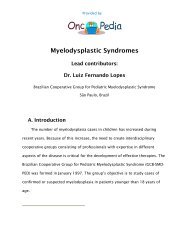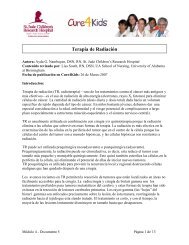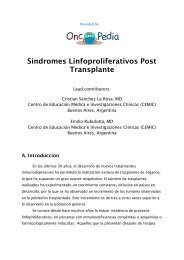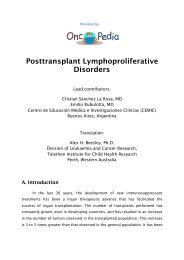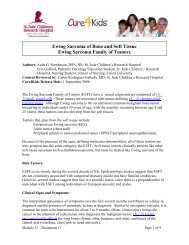Non-rhabdomyosarcoma soft tissue sarcomas (NRSTS)
Non-rhabdomyosarcoma soft tissue sarcomas (NRSTS)
Non-rhabdomyosarcoma soft tissue sarcomas (NRSTS)
You also want an ePaper? Increase the reach of your titles
YUMPU automatically turns print PDFs into web optimized ePapers that Google loves.
<strong>Non</strong>-<strong>rhabdomyosarcoma</strong> <strong>soft</strong> <strong>tissue</strong> tumors (<strong>NRSTS</strong>)<br />
Chemotherapy has not been proven to improve outcome substantially in adults with <strong>soft</strong> <strong>tissue</strong><br />
<strong>sarcomas</strong>, so its use remains controversial. However, it has a clear place in the neoadjuvant<br />
setting for patients with unresectable tumors, where it may facilitate gross tumor resection. The<br />
benefit of chemotherapy in the adjuvant treatment of children with <strong>NRSTS</strong> is less clear, though it<br />
is likely to be most helpful in patients with non-metastatic, large, high-grade tumors who are at<br />
high risk for distant metastatic recurrence. Even in this population, its use may be appropriately<br />
restricted to histologic subtypes known to be relatively chemosensitive, such as synovial<br />
sarcoma.<br />
Future Directions:<br />
Studies aimed at improving our understanding of the biology and clinical behavior of <strong>NRSTS</strong> are<br />
underway. Although surgery remains the most important treatment modality, the roles of<br />
chemotherapy and radiation therapy are being investigated. Risk-based treatment approaches are<br />
being tested in both U.S. and European studies to determine which patients require adjuvant<br />
therapy. Further study is also needed to assess the long-term toxicity of various treatment<br />
approaches in <strong>NRSTS</strong>.<br />
Module 13 - Document 22 Page 4 of 12



